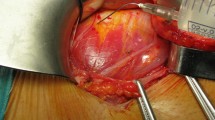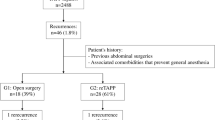Abstract
Purpose
Inguinal hernia repairs should have few complications and a short learning curve. A new operation called Onstep has promising results, but still some recurrences. The aim of the study was to find reasons for recurrence, by studying the re-operations.
Methods
The study is a case series, where 565 patients operated with Onstep at six hospitals between December 2011 and April 2015 were identified. If a recurrence had occurred, the description of the re-operation was studied and compared to the primary Onstep operation.
Results
We found 26 inguinal hernia recurrences, giving a recurrence rate of 4.6 %. The reasons for recurrence were a cranial displacement of the mesh in five patients, a caudal displacement in three patients, a folded mesh in one patient, and broken sutures in the mesh laterally in six patients. We found indications of a learning curve, since 70 % of the recurrences had their primary operation among the first half of the total Onstep procedures. Another finding was that 30 patients had complaints from the ring in the mesh, and most of these patients were slender. Fifteen patients have had the ring removed, and for six patients with a follow-up, the complaints have been reduced or disappeared.
Conclusions
The main reasons for recurrence may be broken sutures in the mesh laterally or a suboptimal size of the opening in fascia transversalis medially, enabling the mesh to displace. Furthermore, the results suggest a learning curve. These findings may guide further improvement in the Onstep method for inguinal hernia repair.

Similar content being viewed by others
References
Kingsnorth A (2004) Treating inguinal hernias. BMJ 328:59–60
Lourenco A, da Costa RS (2013) The ONSTEP inguinal hernia repair technique: initial clinical experience of 693 patients, in two institutions. Hernia 17:357–364. doi:10.1007/s10029-013-1057-z
Andresen K, Burcharth J, Rosenberg J (2015) The initial experience of introducing the Onstep technique for inguinal hernia repair in a general surgical department. Scand J Surg 104:61–65. doi:10.1177/1457496914529930
Miserez M, Alexandre JH, Campanelli G, Corcione F, Cuccurullo D, Pascual MH et al (2007) The European Hernia Society groin hernia classification: simple and easy to remember. Hernia 11:113–116
Brown RP (1992) Knotting technique and suture materials. Br J Surg 79:399–400
Brouwers JE, Oosting H, de Haas D, Klopper PJ (1991) Dynamic loading of surgical knots. Surg Gynecol Obstet 173:443–448
van Rijssel EJ, Trimbos JB, Booster MH (1990) Mechanical performance of square knots and sliding knots in surgery: comparative study. Am J Obstet Gynecol 162:93–97
Bokeler U, Schwarz J, Bittner R, Zacheja S, Smaxwil C (2013) Teaching and training in laparoscopic inguinal hernia repair (TAPP): impact of the learning curve on patient outcome. Surg Endosc 27:2886–2893. doi:10.1007/s00464-013-2849-z
Burcharth J, Pommergaard HC, Bisgaard T, Rosenberg J (2015) Patient-related risk factors for recurrence after inguinal hernia repair: a systematic review and meta-analysis of observational studies. Surg Innov 22:303–317. doi:10.1177/1553350614552731
Burcharth J, Andresen K, Pommergaard HC, Bisgaard T, Rosenberg J (2014) Recurrence patterns of direct and indirect inguinal hernias in a nationwide population in Denmark. Surgery 155:173–177. doi:10.1016/j.surg.2013.06.006
Kehlet H, Bay-Nielsen M (2008) Nationwide quality improvement of groin hernia repair from the Danish Hernia Database of 87,840 patients from 1998 to 2005. Hernia 12:1–7
Kald A, Nilsson E, Anderberg B, Bragmark M, Engstrom P, Gunnarsson U et al (1998) Reoperation as surrogate endpoint in hernia surgery: a three year follow-up of 1565 herniorrhaphies. Eur J Surg 164:45–50
Rosenberg J, Andresen K, Laursen J (2014) Team training (training at own facility) versus individual surgeon’s training (training at trainer’s facility) when implementing a new surgical technique: example from the Onstep inguinal hernia repair. Surg Res Pract 2014:762761. doi:10.1155/2014/762761
Gillion JF, Chollet JM (2013) Chronic pain and quality of life (QoL) after transinguinal preperitoneal (TIPP) inguinal hernia repair using a totally extraperitoneal, parietalized, polysoft memory ring patch: a series of 622 hernia repairs in 525 patients. Hernia 17:683–692. doi:10.1007/s10029-013-1121-8
Berrevoet F, Sommeling C, De Gendt S, Breusegem C, de Hemptinne B (2009) The preperitoneal memory-ring patch for inguinal hernia: a prospective multicentric feasibility study. Hernia 13:243–249. doi:10.1007/s10029-009-0475-4
Koning GG, Keus F, Koeslag L, Cheung CL, Avçi M, van Laarhoven CJ, Vriens PW (2012) Randomized clinical trial of chronic pain after the transinguinal preperitoneal technique compared with Lichtenstein’s method for inguinal hernia repair. Br J Surg 99:1365–1373. doi:10.1002/bjs.8862
Andresen K, Burcharth J, Fonnes S, Hupfeld L, Rothman JP, Deigaard S, Winther D, Errebo MB, Therkildsen R, Hauge D, Sørensen FS, Bjerg J, Rosenberg J (2015) Short-term outcome after Onstep versus Lichtenstein technique for inguinal hernia repair: results from a randomized clinical trial. Hernia 19:871–877. doi:10.1007/s10029-015-1428-8
Andresen K, Burcharth J, Rosenberg J (2015) ONSTEP versus laparoscopy for inguinal hernia repair: protocol for a randomised clinical trial. Dan Med J 62:A5169
Amid PK, Shulman AG, Lichtenstein IL (1993) Critical scrutiny of the open “tensionfree” hernioplasty. Am J Surg 165:369–371
Bay-Nielsen M, Nordin P, Nilsson E, Kehlet H (2001) Operative findings in recurrent hernia after a Lichtenstein procedure. Am J Surg 182:134–136
Neumayer L, Giobbie-Hurder A, Jonasson O, Fitzgibbons R Jr, Dunlop D, Gibbs J et al (2004) Open mesh versus laparoscopic mesh repair of inguinal hernia. N Engl J Med 350:1819–1827
Kumar S (2004) Open mesh versus laparoscopic mesh hernia repair. N Engl J Med 351:1463–1465 (author reply-5)
Phillips EH, Rosenthal R, Fallas M, Carroll B, Arregui M, Corbitt J et al (1995) Reasons for early recurrence following laparoscopic hernioplasty. Surg Endosc 9:140–144 (discussion 144–145)
Heikkinen T, Bringman S, Ohtonen P, Kunelius P, Haukipuro K, Hulkko A (2004) Five-year outcome of laparoscopic and Lichtenstein hernioplasties. Surg Endosc 18:518–522
Simons MP, Aufenacker T, Bay-Nielsen M, Bouillot JL, Campanelli G, Conze J et al (2009) European Hernia Society guidelines on the treatment of inguinal hernia in adult patients. Hernia 13:343–403. doi:10.1007/s10029-009-0529-7
Author information
Authors and Affiliations
Corresponding author
Ethics declarations
Conflict of interest
SÖ reports no potential conflicts of interest, KA reports personal fees from Bard outside the submitted work, DH reports no potential conflicts of interest, JR reports grants from Johnson & Johnson, grants and personal fees from Bard, personal fees from Merck, outside the submitted work.
Ethical approval
The study was approved by the Danish Data Protection 76 Agency (Journal number 03142, ID: HEH-2014-084). The 77 study did not need ethical approval according to the Danish 78 law.
Financial support
This study received no financial support from extramural sources.
Rights and permissions
About this article
Cite this article
Öberg, S., Andresen, K., Hauge, D. et al. Recurrence mechanisms after inguinal hernia repair by the Onstep technique: a case series. Hernia 20, 681–685 (2016). https://doi.org/10.1007/s10029-016-1496-4
Received:
Accepted:
Published:
Issue Date:
DOI: https://doi.org/10.1007/s10029-016-1496-4




